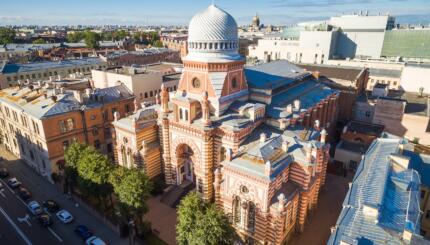In 1850 two men found themselves standing under a tree near the famous Recoleta Cemetery in the center of Buenos Aires. Each man was carrying a small book and reading to himself. It was Yom Kippur and each man prayed silently to himself without saying a word, even though they each knew what the other was doing. After finishing their prayers they started to talk and they agreed to meet next year and to try to find some more Jews. The year after this story the first minyan took place for Yom Kippur and they decided to found the Congregacion Israelita de la Republica Argentina, the first Jewish Institution in Argentina.
When I asked Rabbi Guido Cohen about the history of Jewish life in Argentina, this was the legend he shared, truth or fiction it is hard to say, but as he pointed out the tree is still there.
The roots of Jewish life in Argentina are relatively new, prior to the late 1800s there had been a small smattering of Sephardic Jews who had come to the country but the Inquisition followed and all signs of Jewish life disappeared. The eradication of the Inquisition in 1813 paved the way for the potential of Jewish life but it was not until the very end of the 19th century that large numbers of Jews began to settle in Argentina.
Today Argentina is the home to the world’s largest Spanish speaking Jewish community. There are over 250,000 Jews in Argentina, most living in Buenos Aires. The earliest European Jewish settlers, however, initially made their homes on the Pampas, the vast Argentinean plains, where it was common to find Jewish cowboys.
In many ways Jewish life in Buenos Aires bears a strong resemblance to Jewish life in any major North American city. There are a myriad of synagogues, Jewish organizations and schools. The arts scene is vibrant and there a Conservative Seminario Rabínico Latinoamericano, which like it’s American counterparts, trains rabbis. On a recent Friday, I attended a Shabbat Service in the center of the city. The tunes were a recognizable mix of contemporary liturgical music used in the United States.
But even as it is familiar, there is no mistaking Buenos Aires for Boston or Los Angeles. While visiting, Rabbi Cohen offered to take me to see a local synagogue, which he promised, would be quite special. Walking into the courtyard and then the sanctuary of Amijai, it was easy to understand what he was talking about. Set amidst greenery, the building is modern and rounded, the sanctuary made of Jerusalem stone and the acoustics state of the art.
But it was Cohen’s comment as we left that reminded us of exactly where we were, “not only is this the most beautiful shul in the city, it is also the safest.”
Concern for safety is real. In 1994, the Jewish Community Center was bombed and 85 people were killed and over 200 wounded. Moving around town with the World Union of Progressive Judaism we were never without our security team. Moreover, the economic instability that plagued the country in 2001 led to significant migration to Israel, the United States, Spain and Canada. As proud as Argentineans are, they have reasons to worry too.
Still Jewish life is vibrant and uniquely Latin American. Though concerns about safety abound, there are 1,500 students at the Tarbut Jewish school where Rabbi Cohen directs Jewish life and learning, and this is only one of many openly Jewish schools. Jewish children are educated to be multi lingual. Though not particularly religious –the numbers for intermarriage that I heard while there varied but were around 50% – people are proud to be Jewish. Recently, the city elected Rabbi Sergio Bergman to an important seat on the city council. Buenos Aires boasts more than a dozen kosher eateries including the only kosher McDonald’s outside of Israel. The popular ten member Samaj band has a really local flavor. It plays a mix of Klezmer, Israeli and Latin music, that had us dancing for hours one night at our conference.
Today the Recoleta Cemetery is in the center of one of Buenos Aires’ most posh neighborhood which buzzes with life at all hours of the day and night. It is hard to imagine that it was ever a place where two Jews might find some quiet for reflection on Yom Kippur. Yet, if those fabled men were by some extraordinary means to come looking for Jewish life in Buenos Aires today they would be far from alone as they were just over a century and a half ago, instead they would be in the midst of the worlds most vibrant Jewish communities. The biggest question they would face would be choosing which synagogue to attend!
kosher
Pronounced: KOH-sher, Origin: Hebrew, adhering to kashrut, the traditional Jewish dietary laws.
minyan
Pronounced: MIN-yun, meen-YAHN, Origin: Hebrew, quorum of 10 adult Jews (traditionally Jewish men) necessary for reciting many prayers.
Sephardic
Pronounced: seh-FAR-dik, Origin: Hebrew, describing Jews descending from the Jews of Spain.
Shabbat
Pronounced: shuh-BAHT or shah-BAHT, Origin: Hebrew, the Sabbath, from sundown Friday to sundown Saturday.
shul
Pronounced: shool (oo as in cool), Origin: Yiddish, synagogue.
Yom Kippur
Pronounced: yohm KIPP-er, also yohm kee-PORE, Origin: Hebrew, The Day of Atonement, the holiest day on the Jewish calendar and, with Rosh Hashanah, one of the High Holidays.



